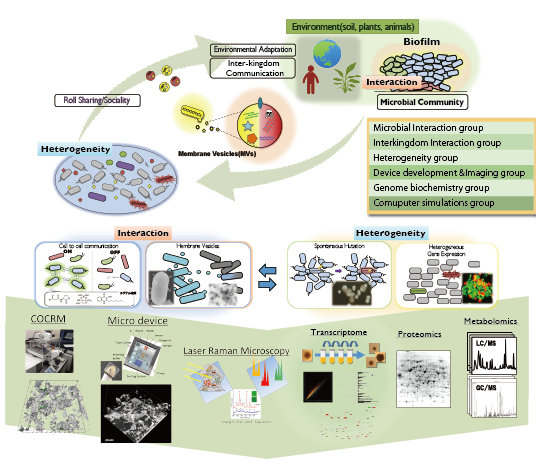Our Project
Microbial communities demonstrate a wealth of behavior in response to environmental stimuli due to the variety of and interactions between microbes in these communities. Furthermore, they have a significant impact on human life and well-being, highlighting the need for innovative technologies to control microbial community development.
This project aims to elucidate the behavior of individual bacteria within communities and interactions between communities. We aim to clarify community adaptation to the environment and microbial interactions with other environmental organisms. To achieve this, we will develop novel technologies to image and analyze microbial communities from the individual to the community level. We will clarify the role of heterogeneity and cell-cell interactions within these communities.
Our second aim is to deepen our understanding of multi-species microbe ecology, such as fungi-bacteria interactions, through studying interactions mediated by extracellular particles emitted by bacteria. Finally, we aim to develop new technologies with predictive capabilities of bacterial behavior to control microbial community development.

Groups
Microbial Interaction group | members
Bacterial exhibit multicellular behaviors such as biofilm formation. We aim to understand what kind of cell to cell interactions are involved in single cell levels, and understand how they impact the collective behaviors of bacteria. These understandings would potentially provide us new platforms to control bacterial populations.
Interkingdom Interaction group | members
Microorganisms are symbiotic with animals and plants in nature. This symbiotic relationship includes parasitism by pathogenic microorganisms and mutualism between humans and intestinal bacteria. This group aims to understand the overall picture of the interaction between microorganisms and animals and plants in symbiotic relationships. Based on these understanding, we will lead to the development of not only the control technology of pathogenic microorganisms but also the utilization technology of useful microorganisms.
Heterogeneity group | members
Microbial populations are not homogeneous, rather, they are ripe with heterogeneities such as gene expression noise, spontaneous mutations, horizontal gene transfers, and accumulation of metabolites and extracellular secretions. Heterogeneity is important for the maintenance of the microbial population. Our research group aims at building the foundation for controlling microorganisms through understanding heterogeneity in the microbial community.
Device development & Imaging group | members
We will combine techniques from different fields such as mechanical and chemical engineering to soft-matter physics, utilizing advanced imaging and microfabrication technology to develop novel devices to analyze microbial behavior, from the individual to the community level. Fundamental understanding will lead to control.
Genome biochemistry group | members
Our aim is to elucidate members of complex microbial population by metagenomic analysis. To obtain knowledge of the heterogeneity in the microbial population both qualitatively and quantitatively, we will separate and collect the microbial population spatiotemporally by using a cell sorter and a laser microdissection system (LMD) and get comprehensive information of gene mutation, epigenetics, gene expression, protein and metabolite by the genome-transcriptome-metabolome analysis.
Computer Simulations group | members
Natural environment surrounding microbes is changing actively and spatiotemporally. Various types of microbes form complicated interactional networks. With conventional research method depending on human's ability, such dynamic and multiple variables world can not be identified. Our group do experiments over human scale and precision by using AI(Machine Learning) and Robotics so that we can find principal and structures hidden in the microbial ecology.










